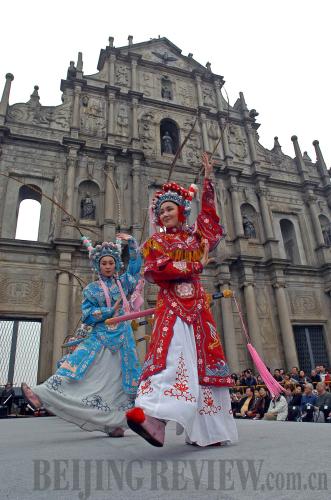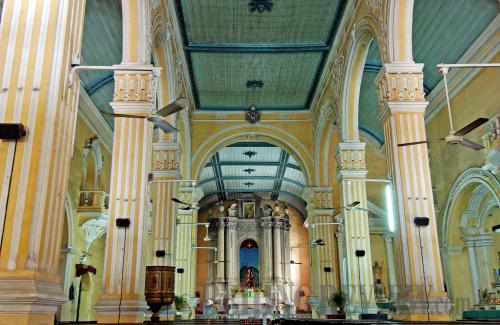|
 |
|
ATTRACTION: The ruins of St Paul’s, with a history of more than 350 years, are now a major scenic site (XINHUA) |
Macao released a draft law in February this year for submissions and it is still being deliberated. In the past years, as part of cooperation between Macao, Hong Kong and Guangdong, a fund on cultural heritage protection was established for ICH protection.
A part of life
Already the centerpiece of Macao, the Historic Center is also often used as a venue for various performances and exhibitions promoting the city's image.
 |
|
RELIGIOUS MACAO: St. Augustine’s Catholic Church, built in 1866, is one of the three oldest churches in the city (XINHUA) |
"We hope to preserve some unique elements of Macao's culture through promotional activities such as music and art festivals," Ho said.
She said a characteristically local type of drama in which performers speak an indigenous language—a mixture of Portuguese, Cantonese and other tongues—had become a regular part of the program for the Macao Arts Festival every year.
She summarized the work done by the Cultural Affairs Office in the past decade: playing guardian for a rich collection of cultural heritage, establishing two cultural bases serving Macao—the Macao Conservatory and the Macao Museum; and bringing to the forefront four cultural brands that now enjoy global fame—the Macao International Music Festival, the Macao Arts Festival, the Macao Orchestra and the Macao Chinese Orchestra.
Thanks to cooperation between the Macao Conservatory and the Shanghai Theater Academy and Beijing-based Central Conservatory of Music, Macao began to offer secondary vocational education for dance and vocal students in 2005 and 2009, respectively.
Macao also invites first-class performing troupes and orchestras to perform during the two festivals, including mainland musicians and artists. The Cultural Affairs Office has invited eminent local composers to create Macao-themed music for citizens and tourists.
De Cheng An, once the largest hockshop in Macao, serves as another perfect example of lively preservation. It was handed by the Macao SAR Government to civilian-run enterprises after restoration and maintenance. Since then, the shop has been a permanent venue for the Pawnbroking Exhibition and Cultural Assembly Hall. It was honored in 2004 with a UNESCO Heritage Award because of its successful restoration and utilization.
As a successful example of a city's historic and cultural heritage protection and utilization, a replica of the shop will appear at the Urban Best Practice area at the 2010 Shanghai Expo. By then, 15 characters from the works of Louis Cha, the Hong Kong-based author of martial arts novels, will be on show.
Still, Macao faces many challenges in the protection of its Historic Center and architecture within the site. Lack of land has impeded Macao from developing more quickly and also affected protection of the center. Vivid and lively though, the center is now with citizens living within it, and contradictions between the center and the region's new zone gained from land accretion have begun to surface. UNESCO warned the Macao SAR Government of the threat to the Songshan Lighthouse posed by the height of surrounding buildings in 2007.
Because of Macao's limited area, heritage objects have to strive for sunlight amid increasingly dense clusters of urban architecture, while living and transportation facilities in the old city no longer meet the need of the ballooning population. | 